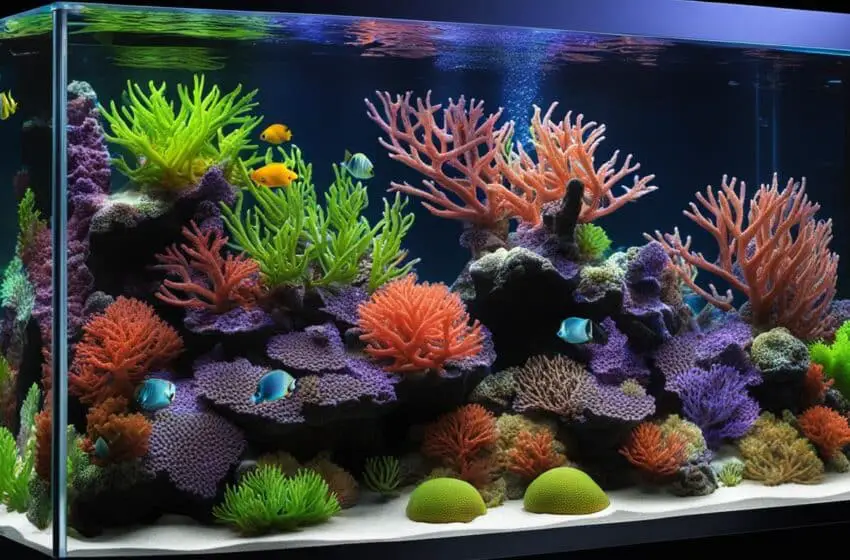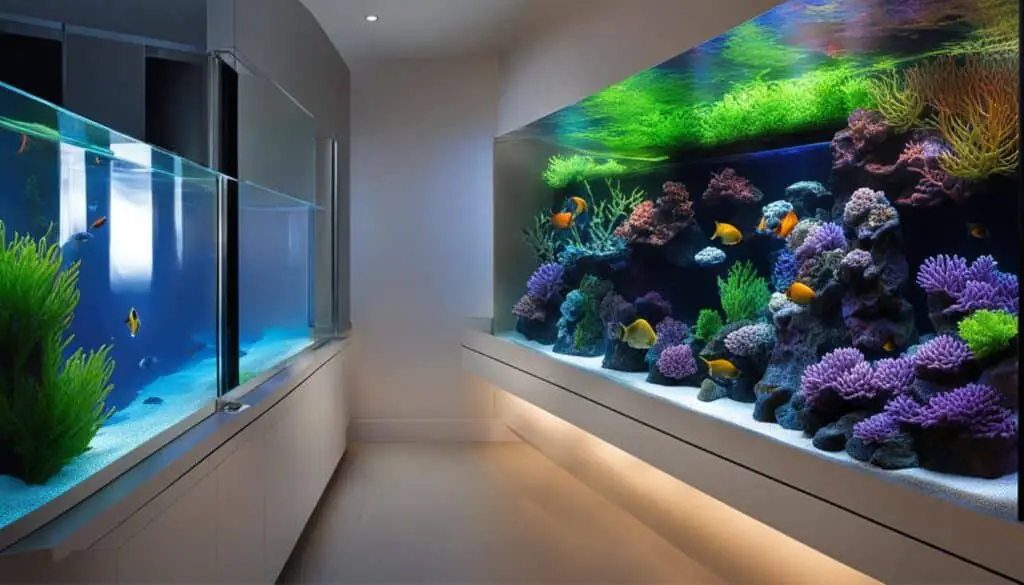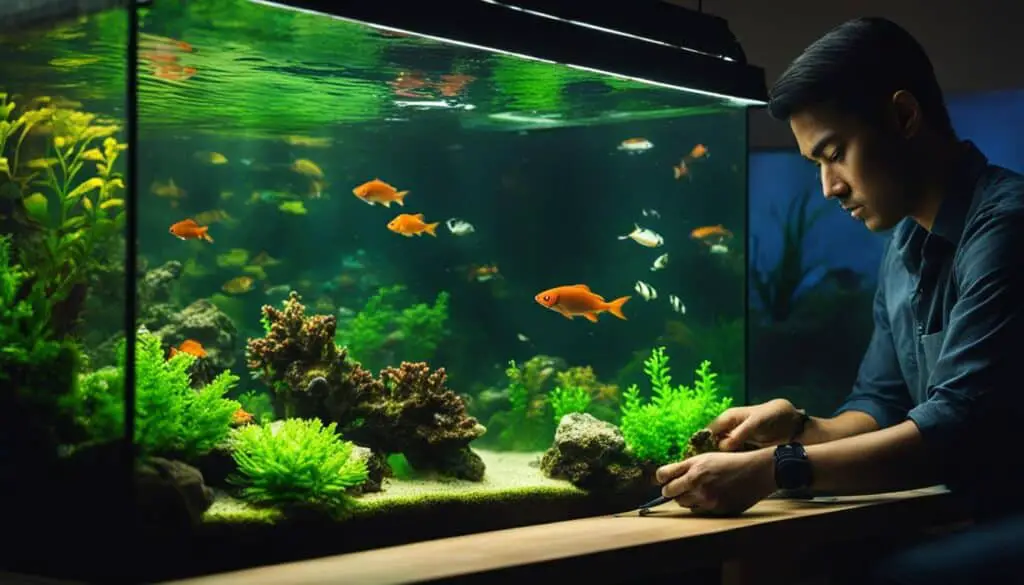Saltwater Aquarium Lighting Guide

Welcome to the Saltwater Aquarium Lighting Guide! In this comprehensive guide, I will provide you with essential tips and insightful information on the latest trends in lighting for marine aquariums. Whether you’re a seasoned aquarium enthusiast or just starting out, understanding the importance of lighting in your saltwater tank is crucial for the health and development of your aquatic inhabitants.
Marine aquarium lighting goes beyond mere illumination; it plays a vital role in replicating natural environments, enhancing the colors and growth of corals, and creating a visually stunning and balanced aquatic ecosystem. By staying up to date with the latest lighting trends and incorporating modern marine aquarium design elements, you can create a captivating underwater world that will be the envy of all who see it.
The Saltwater Aquarium Lighting Guide covers a wide range of topics, from choosing the right lighting options for your tank to maintaining and troubleshooting common lighting issues. You’ll discover the benefits of LED lighting, the impact of the right spectrum and intensity of light on coral health, and the cutting-edge advancements in aquarium lighting technology.
As you dive deeper into this guide, you’ll also explore the latest trends in modern marine aquarium lighting, including innovative wireless lighting control systems and compact equipment solutions. We’ll even touch on the fascinating trend of keeping jellyfish as pets and the crucial role of aquarium hobbyists in species conservation.
So, whether you’re an experienced aquarist seeking to upgrade your lighting setup or a beginner looking for guidance, this Saltwater Aquarium Lighting Guide has got you covered. Get ready to unlock the secrets of optimal lighting for your marine aquarium and create a breathtaking underwater masterpiece.
Key Takeaways:
- Choosing the right lighting is crucial for the health and aesthetic appeal of a saltwater aquarium.
- LED lighting offers various benefits, including energy efficiency and customizable options.
- The right spectrum and intensity of light are essential for optimal growth and coloration in corals.
- Stay informed about the latest trends in modern marine aquarium lighting, such as wireless control systems and compact equipment solutions.
- Proper maintenance and troubleshooting help ensure the longevity and effectiveness of your aquarium lighting system.
Choosing the Right Aquarium Lighting
When it comes to creating the perfect environment for your saltwater aquarium, choosing the right lighting is essential. The right lighting not only enhances the visual appeal of your aquarium but also plays a crucial role in the health and well-being of your fish and corals. In this section, we will explore the different lighting options available, with a particular focus on LED lighting, and how it can optimize fish and coral health.
Lighting Options
There are various lighting options to consider when setting up your saltwater aquarium. LED lights have become increasingly popular due to their efficiency, longevity, and versatility. LED lighting provides a wide range of customizable options, including intensity control, color spectrum adjustment, and even simulated moonlight settings. This versatility allows aquarists to recreate natural lighting conditions, closely mimicking the underwater environment.
Other lighting options include fluorescent and metal halide bulbs. While these traditional options are still used by some aquarists, LED lighting has emerged as the preferred choice for its energy-saving features, ability to produce the desired light spectrum, and minimal heat output. LED lights also provide a more uniform distribution of light, ensuring that every corner of your aquarium receives proper illumination.
Impact on Fish and Coral Health
The right spectrum and intensity of light play a crucial role in the growth and coloration of corals and the overall health of your fish. Corals rely on light to photosynthesize and obtain essential nutrients, so it is crucial to provide them with the appropriate lighting conditions. LED lights can be adjusted to deliver the ideal light spectrum for corals’ specific needs.
Additionally, LED lighting allows for precise control of light intensity, preventing overexposure that can harm corals and fish. High-intensity lighting options like metal halide bulbs can produce excessive heat, leading to temperature fluctuations that can stress or even kill delicate coral species. LED lights, on the other hand, generate minimal heat, ensuring a stable and safe environment for your aquatic inhabitants.
Furthermore, LED lighting promotes the growth of beneficial photosynthetic bacteria on live rock and other surfaces, enhancing the overall biological filtration of your aquarium. This helps maintain optimal water quality, reducing the risk of harmful pollutants and ensuring a healthier environment for your fish and corals.
Advancements in LED Lighting Technology
LED lighting technology has witnessed significant advancements in recent years, revolutionizing the way we illuminate our aquariums. These advancements have made aquarium lighting systems more efficient, customizable, and user-friendly.
One notable advancement is the ability to control LED lights wirelessly. This allows for easy programming and adjustment of lighting settings, such as intensity, color, and moonlight cycles, without the need for manual adjustments. Wireless lighting control systems offer convenience and flexibility, enabling aquarists to create dynamic lighting effects and simulate natural day and night cycles with ease.
Another innovation is the use of specialized LED light fixtures designed specifically for coral growth and coloration. These fixtures often feature multiple channels of LED lights, each emitting a different spectrum of light to cater to the unique requirements of different coral species. This specialization ensures that corals receive the specific light wavelengths they need for optimal health and vibrant coloration.
Overall, the advancements in LED lighting technology have made it easier than ever to provide the perfect lighting conditions for your saltwater aquarium, promoting the health and beauty of your fish and corals.
Choosing the right lighting for your saltwater aquarium is a critical decision that can significantly impact the health and aesthetics of your aquatic ecosystem. LED lighting offers numerous advantages, including energy efficiency, customization options, and the ability to promote fish and coral health. By understanding the different lighting options available and the impact they have on your aquarium inhabitants, you can create a captivating and thriving underwater world.
Trends in Modern Marine Aquarium Lighting
The world of modern marine aquarium lighting is continuously evolving, with new trends and innovations constantly emerging. Keeping up with these advancements is essential for aquarium enthusiasts looking to create visually stunning and environmentally friendly setups for their marine tanks.
Wireless Lighting Control Systems
One of the significant trends in modern marine aquarium lighting is the use of wireless control systems. These innovative solutions allow aquarium owners to adjust and customize their lighting settings using mobile apps or remote control devices. With wireless lighting control, hobbyists can easily create dynamic lighting schedules, simulate natural day and night cycles, and even sync their lighting with other smart home devices.
Compact and Energy-Efficient Equipment
Another trend in modern marine aquarium lighting is the development of compact and energy-efficient lighting equipment. LED technology has revolutionized the industry, providing powerful lighting solutions in a smaller form factor. LED lights consume less electricity, generate less heat, and have a longer lifespan compared to traditional lighting options, making them an eco-friendly choice for modern aquarium setups.

Colorful Species and Nano Tanks
Aesthetics play a crucial role in modern marine aquarium designs, and incorporating colorful species and nano tanks has become a popular trend. Nano tanks, which are small-scale aquariums with a capacity of 30 gallons or less, provide a unique and visually striking display. Pairing these tanks with vibrant and colorful marine species, such as exotic fish, corals, and invertebrates, creates a mesmerizing underwater world.
“The combination of wireless lighting control, compact equipment, and colorful species allows aquarium enthusiasts to explore endless possibilities in designing their marine tanks.” – Marine Aquarium Design Expert
Sophisticated Water Quality Monitoring
In the realm of modern marine aquarium lighting, advanced water quality monitoring devices are gaining popularity. These devices can measure parameters such as temperature, pH levels, and salinity, providing real-time data to ensure optimal conditions for marine life. Some systems even offer wireless connectivity, allowing aquarists to monitor and adjust water quality parameters remotely.
| Trend | Description |
|---|---|
| Wireless Lighting Control Systems | The use of mobile apps or remote control devices to adjust and customize lighting settings. |
| Compact and Energy-Efficient Equipment | LED lighting technology that is eco-friendly, consumes less electricity, and has a longer lifespan. |
| Colorful Species and Nano Tanks | Incorporating vibrant and exotic species in visually appealing nano tanks. |
| Sophisticated Water Quality Monitoring | Advanced devices for real-time monitoring and adjustment of water quality parameters. |
By embracing these trends and incorporating innovative lighting solutions, modern marine aquarium enthusiasts can create captivating underwater landscapes while ensuring optimal growth and well-being for their marine organisms.
Maintaining and Troubleshooting Aquarium Lighting
Proper maintenance and troubleshooting are crucial for maintaining the effectiveness and longevity of your aquarium lighting system. By following these tips and guidelines, you can ensure that your marine tank is well-lit and free from common lighting issues.
Maintaining Your Aquarium Lighting Fixtures
Regular maintenance is key to keeping your aquarium lighting fixtures in optimal condition. Here are some maintenance tips:
- Clean the light fixtures regularly to remove dust, algae, and other debris that may block the light.
- Use a soft cloth or sponge to wipe the fixtures gently.
- If the fixtures are submerged, make sure to turn off the power and disconnect them from the electrical source before cleaning.
- Replace any damaged or worn-out bulbs or LED modules promptly to maintain the desired light intensity and spectrum.
- Inspect the wiring and connections regularly to ensure there are no loose or damaged parts.

Troubleshooting Common Lighting Issues
Even with proper maintenance, lighting issues can sometimes arise. Here are some common issues and troubleshooting tips:
| Issue | Troubleshooting Tip |
|---|---|
| Flickering lights | Check for loose connections and ensure that the bulbs or LED modules are securely in place. If the issue persists, replace the bulbs or modules. |
| Dimming lights | Inspect the power supply and wiring connections. Dimming lights can be a sign of inadequate power supply or faulty wiring. |
| Uneven lighting | Adjust the positioning of the light fixtures to ensure even distribution of light throughout the tank. Consider adding reflective surfaces or additional lighting fixtures if necessary. |
| Excessive heat | If the lighting fixtures generate excessive heat, make sure they are well-ventilated. Consider using cooling fans or upgrading to more energy-efficient lighting options. |
Preventing Algae Growth and Using Lighting Timers
Algae growth can be a common issue in aquariums, but proper lighting management can help prevent its excessive growth. Here are some strategies:
- Ensure that your lighting fixtures provide the right spectrum and intensity for your tank’s inhabitants. Different species require different lighting conditions.
- Implement a regular lighting schedule using timers to simulate natural day and night cycles. This helps regulate photosynthesis and can prevent algae overgrowth.
- Monitor nutrient levels in your tank, as excessive nutrients can contribute to algae growth. Regular water testing and proper filtration can help maintain balanced nutrient levels.
By employing these maintenance and troubleshooting techniques, you can ensure that your aquarium lighting system functions optimally, providing the necessary light for your marine tank while minimizing common issues such as flickering lights or excessive algae growth.
Conclusion
In conclusion, a well-designed and properly maintained lighting system is crucial for the health and aesthetic appeal of a saltwater aquarium. Throughout this saltwater aquarium lighting guide, we have covered various aspects of aquarium lighting, including the latest trends, the importance of choosing the right light, and maintaining and troubleshooting lighting systems.
Key takeaways from this guide include the significance of providing the right spectrum and intensity of light for optimal growth and coloration in corals, as well as the advancements in technology that have made aquarium lighting more efficient and customizable. By following the tips and information provided, aquarium enthusiasts can optimize their lighting setup and create a thriving marine environment for their fish and corals.
Remember, a well-lit aquarium not only promotes the health and well-being of your aquatic inhabitants but also enhances the visual appeal of your marine tank. So take the time to research and invest in the right lighting options, regularly maintain your fixtures, and troubleshoot any issues to ensure your saltwater aquarium thrives under the best lighting conditions.
FAQ
What factors should I consider when choosing lighting for my saltwater aquarium?
When choosing lighting for your saltwater aquarium, you should consider factors such as the type of lighting options available, including LED lights, and their impact on the health of fish and corals. It is also important to provide the right spectrum and intensity of light for optimal growth and coloration in corals.
What are some of the latest trends in modern marine aquarium lighting?
Some of the latest trends in modern marine aquarium lighting include the use of wireless control systems, compact aquarium equipment, and sophisticated water quality monitoring devices. Nano tanks and the use of colorful species in marine tanks have also become popular trends in aquarium lighting.
How do I maintain and troubleshoot my aquarium lighting system?
To maintain and troubleshoot your aquarium lighting system, it is important to regularly clean and maintain your lighting fixtures. This includes preventing algae growth and using lighting timers to simulate natural day and night cycles. If you encounter issues such as flickering or dimming lights, troubleshooting techniques can help identify and resolve the problem.



